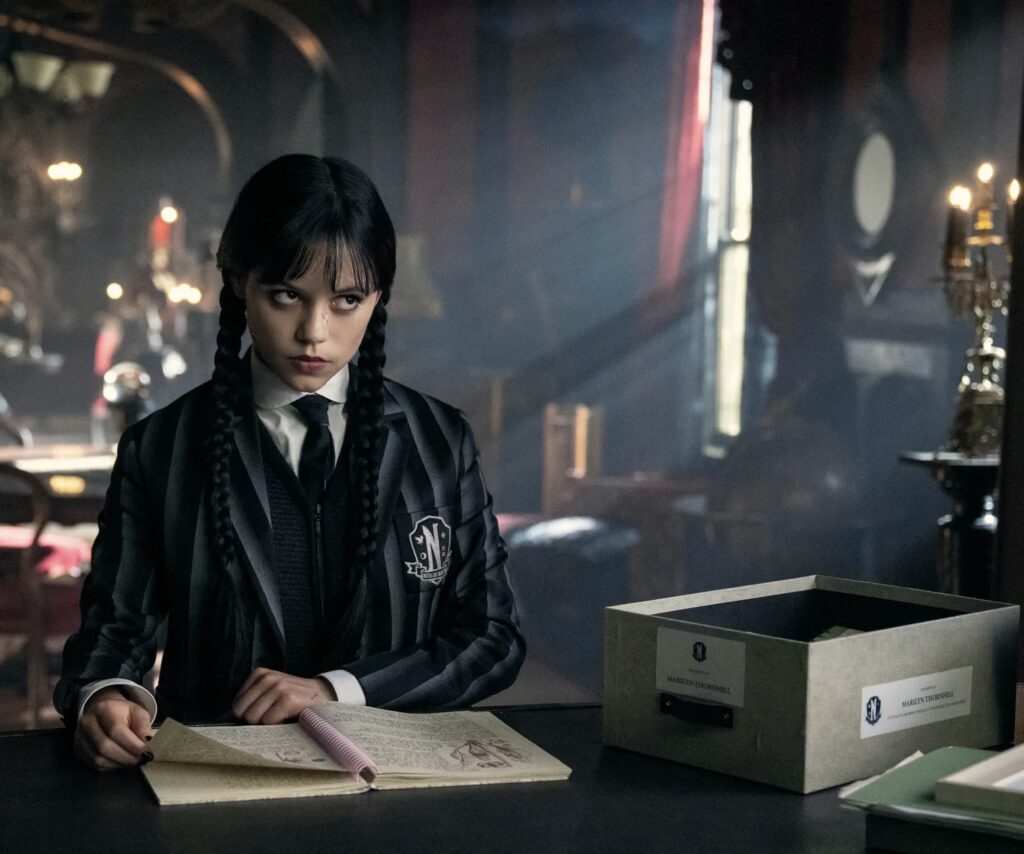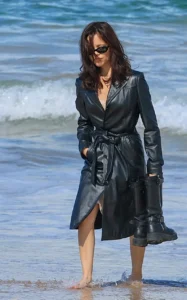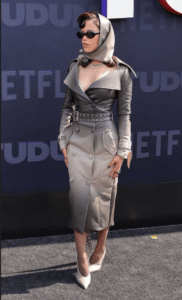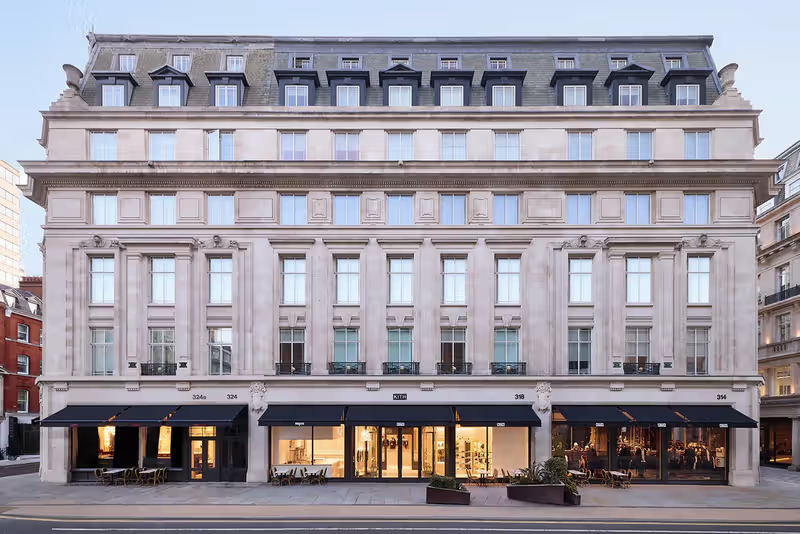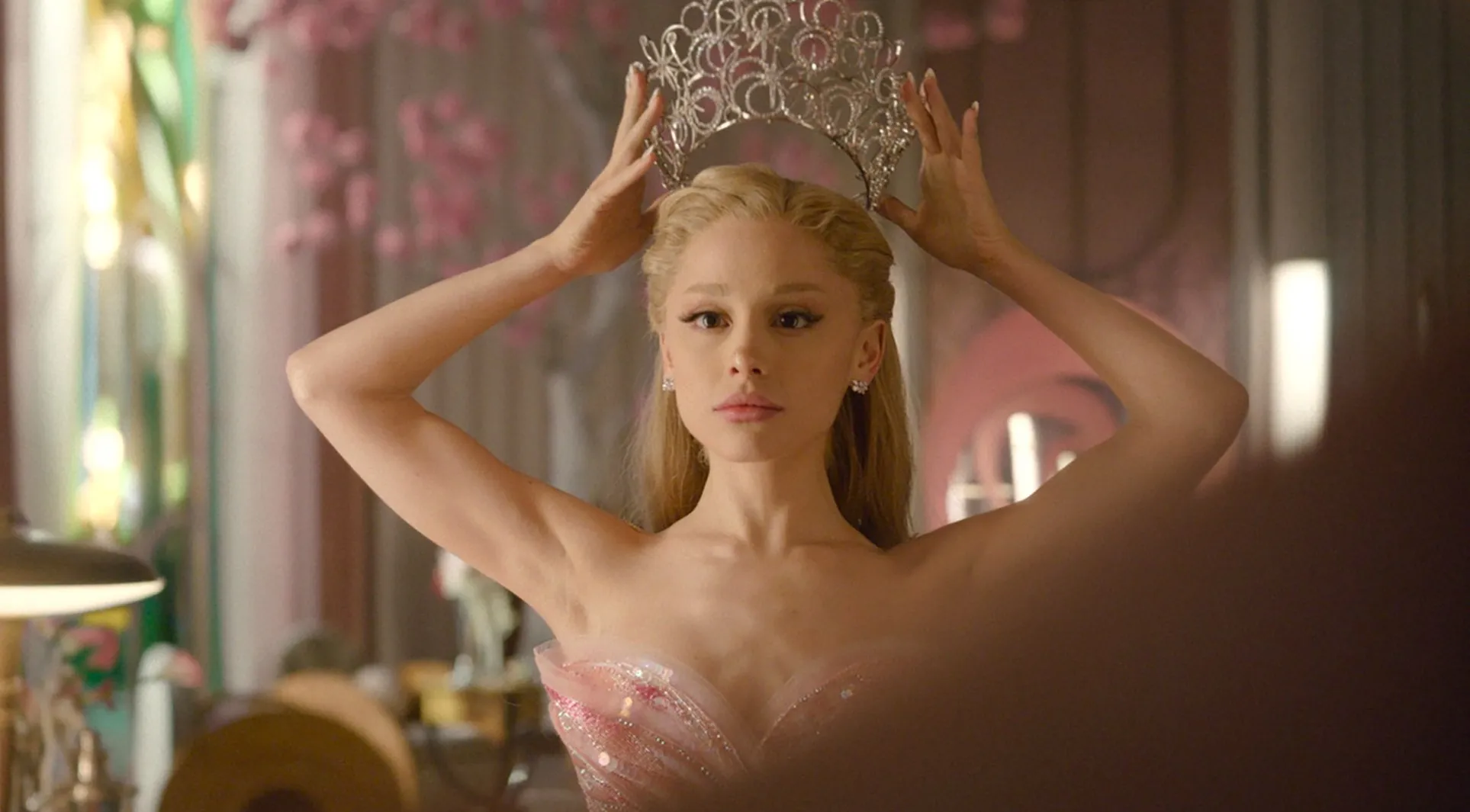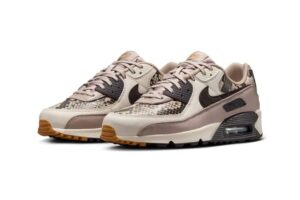The Coat That Never Leaves the Stage
Fashion has its archetypes. Some garments transcend seasonal trends, becoming permanent fixtures in the cultural imagination. The trench coat is one of them — equal parts utilitarian shield and cinematic statement. Yet in 2025, at a time when wardrobes are fragmented by micro-trends, viral aesthetics, and algorithmic styling, the trench coat has reasserted itself as a key garment for identity and narrative. Few contemporary figures embody this revival as convincingly as Jenna Ortega.
At Tudum 2025, Netflix’s annual fan celebration in São Paulo, Ortega arrived in a Markgong ombré trench-dress that blurred the lines between classic tailoring and avant-garde couture. It was not her first trench moment, nor her last. Across her press tours and public appearances — from Bondi Beach in Australia to front-row seats at Paris Fashion Week — Ortega has been using the trench coat motif as a narrative anchor, a way of extending her Wednesday Addams persona into real-world style. What began as a costume code for a fictional character has become a method of celebrity dressing, bridging gothic fantasy with everyday wear.
From Bondi Beach to Gothic Armor
The most emblematic moment came when Ortega appeared on Sydney’s Bondi Beach in a long black leather trench coat, paired with a slip dress and boots casually slung in her hand. It was a deliberate contradiction: heavy leather and a moody silhouette against the backdrop of surf, sand, and sunlight. The image went viral precisely because it answered a question many had been asking: how do you sustain Wednesday Addams-core outside the set and into the chaos of global publicity?
Ortega’s response was not to dilute but to intensify. With the help of her stylist Enrique Melendez, she leaned into the trench as armor — a piece that translates across climates, continents, and contexts. Where most celebrities might opt for breezy linen or silk while in Australia, Ortega doubled down on gothic insistence, reframing the beach not as leisure but as a theatrical stage.
Tudum 2025: The Ombré Trench-Dress
Fast forward to Netflix’s Tudum showcase, where Ortega’s Markgong trench-dress became one of the most discussed looks of the event. Here the trench was reimagined not as outerwear but as sculptural couture. The gradient leather moved from black into ash gray and finally to a faded beige, evoking both decay and transformation. Belted at the waist, with structured shoulders and a hood-scarf, the piece became less about function and more about symbol — a narrative garment that felt both post-apocalyptic and regal.
In wearing this, Ortega not only demonstrated her sartorial confidence but also positioned the trench as a versatile, futuristic essential. In 2025, this matters: the coat is no longer confined to detectives, spies, or classic film noir; it is a garment of reinvention, an outfit that adapts as quickly as Ortega herself.
From Military Origins to Hollywood Glamour
The trench coat originated in military wear — a waterproof, belted piece designed for soldiers in the early 20th century. By mid-century, it had become a Hollywood icon. Humphrey Bogart’s Rick Blaine in Casablanca and Audrey Hepburn’s Holly Golightly in Breakfast at Tiffany’s embedded the coat into cinema’s visual lexicon. It was never just fabric; it was identity shorthand.
Worn by noir detectives, spies, and femme fatales, the trench became synonymous with secrecy, allure, and the blurred lines between public façade and private life. Its adaptability — cinched or loose, buttoned or flowing — made it a perfect narrative device. And like all timeless garments, it evolved beyond its origins into streetwear, luxury fashion, and pop culture styling.
Gothic Appropriations
For decades, gothic and alternative subcultures have reclaimed the trench as both armor and aesthetic marker. From The Matrix’s cyber-goth floor-length black leather coats to punk and post-punk adaptations, the trench carried associations of rebellion and identity construction. Its very length and dramatic drape lent itself to a sense of shadow and mystery.
Ortega’s adoption of the trench taps into this lineage. It is both cinematic homage and subcultural citation — a garment that ties her persona to a broader tradition of gothic self-fashioning.
Fashion in the Age of Viral Motifs
The trench coat is succeeding in 2025 because fashion itself is increasingly motif-driven. TikTok aesthetics come and go — coquette one month, gorpcore the next — but garments that carry meaning hold longevity. The trench is one of these garments. It is instantly recognizable, adaptable to multiple aesthetics (goth, chic, business, grunge), and capable of carrying symbolic weight.
In a world where identity is constantly staged online, the trench coat provides both continuity and drama. Ortega’s insistence on the coat across different global stages suggests that the motif itself is becoming part of her celebrity DNA.
Functionality Meets Fantasy
There is also a practical logic. As fashion recycles and sustainability becomes a consumer priority, investment pieces like trenches thrive. A trench can be restyled endlessly — layered over couture, thrown over casualwear, belted into a dress. In this sense, Ortega’s trench moments are aspirational not just for their aesthetics but also for their pragmatism.
She demonstrates that a single garment can embody fantasy (the gothic persona) while retaining utility (a wearable coat). In 2025, when consumers seek both identity and longevity in their clothing, this duality resonates.
The Jenna Ortega Effect
What makes Ortega’s trench moments powerful is the way they extend her character into real life without becoming costume. Unlike actors who remain visually tethered to a role only in promotional cycles, Ortega has fused Wednesday’s gothic sensibility with her own public-facing style. This is method dressing elevated into persona curation.
By consistently using the trench motif — whether in Paris, Sydney, or São Paulo — she builds a coherent narrative across settings. Fans and media alike recognize the motif, amplifying its impact on social channels. The coat becomes more than clothing; it becomes a media device.
A Symbol
There is also a generational layer. Ortega, born in 2002, belongs to a cohort that is skeptical of superficiality yet deeply invested in performance. For Gen Z, authenticity is often expressed through deliberate aesthetic codes. The trench coat, with its history of concealment, mystery, and self-construction, aligns perfectly with the Gen Z ethos of layered identity.
Her fans do not just see a stylish coat; they see a consistent statement that merges onscreen and offscreen identity into one performative whole.
Impression
In 2025, the trench coat matters because it embodies what fashion now demands: drama with durability, narrative with adaptability. Ortega’s embrace of the motif is not just personal but generational. She shows that a coat can be both costume and canvas, armor and art.
No comments yet.

